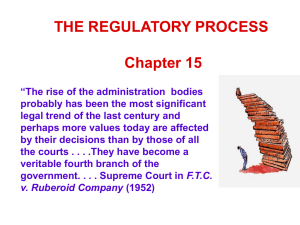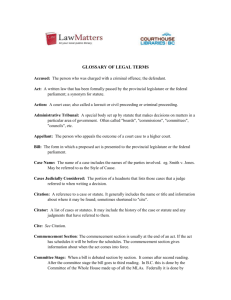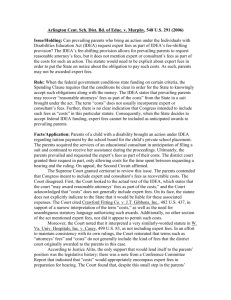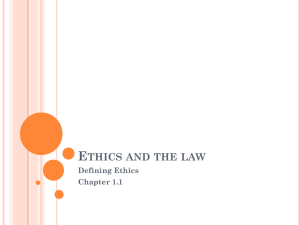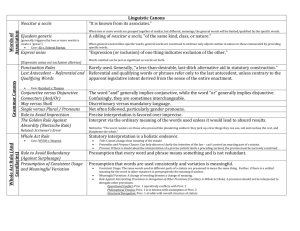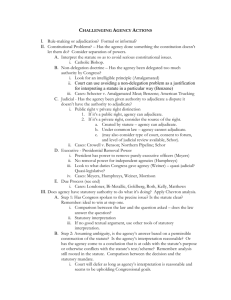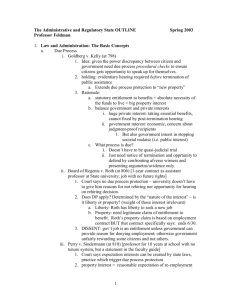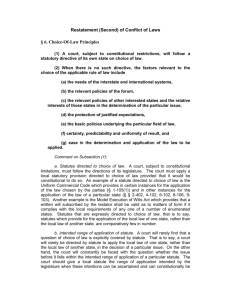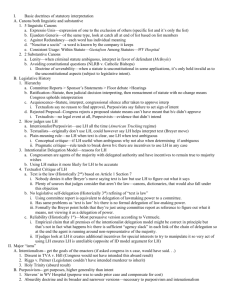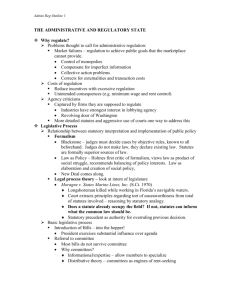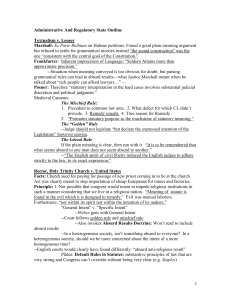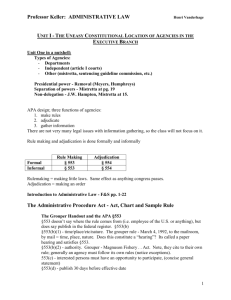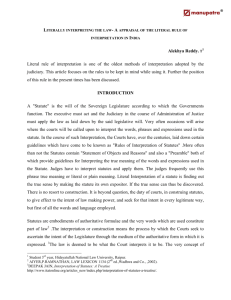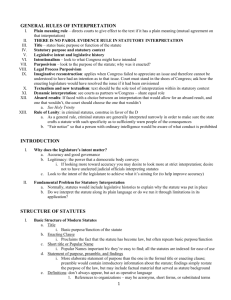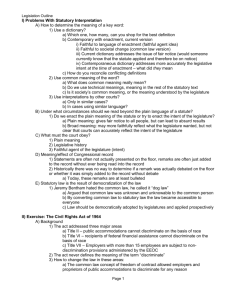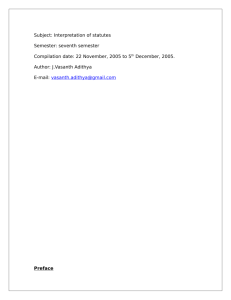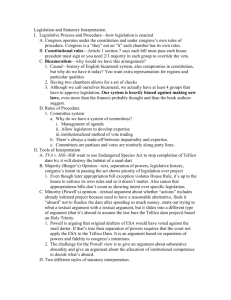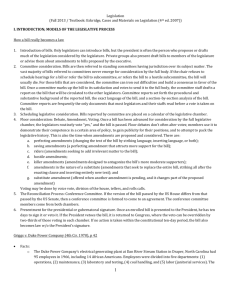Legislative Theories
advertisement
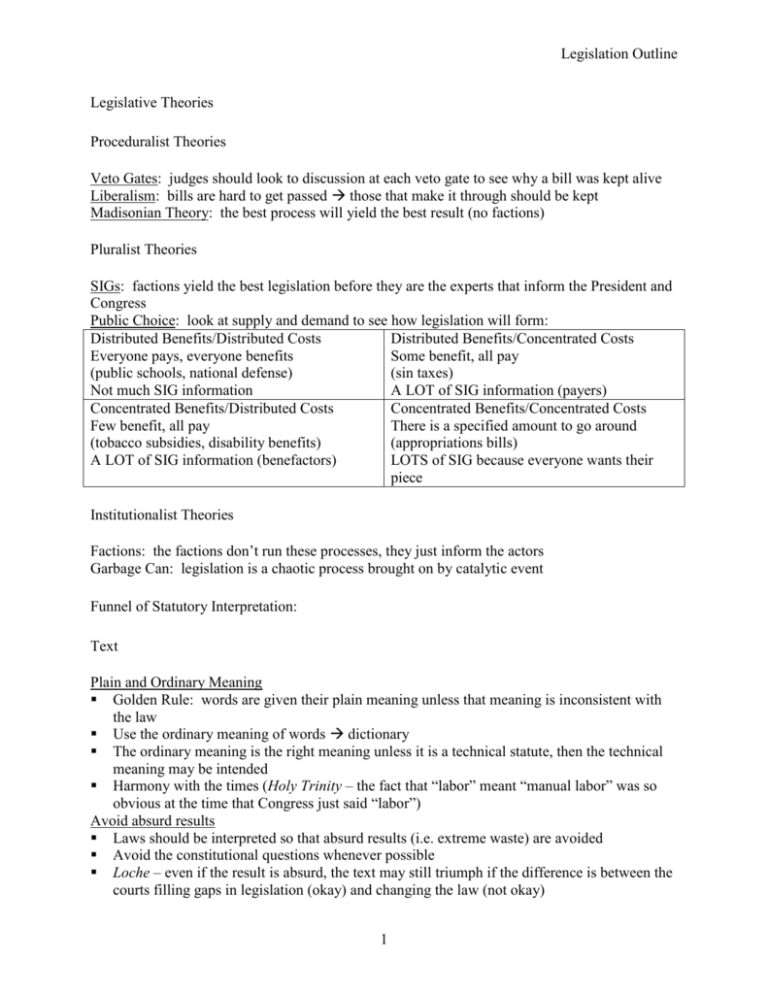
Legislation Outline Legislative Theories Proceduralist Theories Veto Gates: judges should look to discussion at each veto gate to see why a bill was kept alive Liberalism: bills are hard to get passed those that make it through should be kept Madisonian Theory: the best process will yield the best result (no factions) Pluralist Theories SIGs: factions yield the best legislation before they are the experts that inform the President and Congress Public Choice: look at supply and demand to see how legislation will form: Distributed Benefits/Distributed Costs Distributed Benefits/Concentrated Costs Everyone pays, everyone benefits Some benefit, all pay (public schools, national defense) (sin taxes) Not much SIG information A LOT of SIG information (payers) Concentrated Benefits/Distributed Costs Concentrated Benefits/Concentrated Costs Few benefit, all pay There is a specified amount to go around (tobacco subsidies, disability benefits) (appropriations bills) A LOT of SIG information (benefactors) LOTS of SIG because everyone wants their piece Institutionalist Theories Factions: the factions don’t run these processes, they just inform the actors Garbage Can: legislation is a chaotic process brought on by catalytic event Funnel of Statutory Interpretation: Text Plain and Ordinary Meaning Golden Rule: words are given their plain meaning unless that meaning is inconsistent with the law Use the ordinary meaning of words dictionary The ordinary meaning is the right meaning unless it is a technical statute, then the technical meaning may be intended Harmony with the times (Holy Trinity – the fact that “labor” meant “manual labor” was so obvious at the time that Congress just said “labor”) Avoid absurd results Laws should be interpreted so that absurd results (i.e. extreme waste) are avoided Avoid the constitutional questions whenever possible Loche – even if the result is absurd, the text may still triumph if the difference is between the courts filling gaps in legislation (okay) and changing the law (not okay) 1 Legislation Outline TVA: if the text and the statute lead to the same absurd conclusion, the court must uphold that conclusion it is up to Congress to amend the statute so that it works Create harmony with a statute/code Look to similar words and meanings within the statute and the code o In pari materia: if the same language is used in multiple statutes, look to the common meaning or the meaning in earlier statutes (Cartledge v. Miller – there is a general statutory protection of children and domestic issues – apply it to this statute even those the protection is not stated) o Borrowed/Modeled Statute Rule: Borrowed: statute borrowed from another jurisdiction (Zerbe v. State – when borrowing statutes, interpret the borrowed by the original at the time it was borrowed) Modeled: statute modeled on an earlier statute in the same jurisdiction o Do not assume the repeal of a statute: later statutes may explain earlier ones (Morton v. Mancari – do not assume a repeal of an NA protection statute by an equal access statute) Statutory Canons: draw inferences from existing legal presumptions Reference Canons: look to other statutes to draw a connection Textual canons Draw inferences from grammar, placement of words, language and format o Word meaning and association (technical v. ordinary meaning) o Noscitur a sociis: look to the words around the word words are limited/expanded by their neighbors o Ejusdemt generis: general words (“law enforcement”) are limited by specific words in a list (“sheriff, constable”) o Expressio unis: inclusion of one thing excludes the other (a statement listing mules, horses and donkeys does not include turkeys) o Punctuation should aid in construction o “and” v. “or” Not A and B = Not A or Not B Not A or B = Not A and Not B Public Citizen – even though Congress said “or”, they meant “and” because “or” creates an absurd result o May = discretion, shall = mandatory o Rule against surplusage: every word and phrase adds something – you shouldn’t have “leftovers” Legislative History Committee Reports: details expert opinion on the subject and gives Committee’s opinions and recommendations for the bill (Blanchard v. Bergeron) Sponsor Statements: assume that these members are the most knowledgeable about the bill (make sure you look to when the statement was made) Rejected Proposals: may suggest congressional intent to leave something out Floor Debate and Hearings: fair amount of deference (sometimes just a show put on for the cameras) you have to assume that the speakers communicated to other members 2 Legislation Outline Non-legislative Drafters: expresses the opinions of non-legislators (i.e. SIGs, executive) opinions may be clarifying (Kosak v. United States – executive memo conformed with textual interpretation) Inaction: low level of deference because it is negative evidence of an intent Canons of Inaction: o “Dog that won’t bark”: if Congress doesn’t say something is being changed there is no change o Acquiescence Rule: if Congress is aware of an executive/agency interpretation and doesn’t amend the statute to the contrary acquiesces to that interpretation o Re-enactment Rule: if Congress reenacts without substantial changes Courts assume an incorporation of agency interpretation o Rejected Proposal Rule: if Congress specifically rejects language, courts will be careful in using an interpretation based on that language Subsequent Legal Action: Look to Mancari – repeals must be clear (never implied) in subsequent legislation Imaginative Reconstruction Leo Sheep Co. v. United States: there is no text, so look to 1862 Congress this looks like something else, so imagine it is the same and go from there Fishgold – language is clear, but we must look to the situation at the time what would statute have meant? Purpose The purpose of the legislation may provide the best answer (Weber – “spirit of the law” was to provide anti-discrimination to AAs voluntary preferential treatment programs are good under this spirit) Griffin – if the purpose of the statute is to deter bad acts, then the result should show that, even if it is absurd Evolution Statutes evolve with social changes (Johnson – look at preceding statutes to see how evolution leads you to the present case law helps women but does not trammel the rights of men good law) Stare Decisis: decision should stand (Flood v. Kuhn – Congress can rescind acts if it wants to if it doesn’t, that means we keep the status quo) Best Answer Courts will rule that the best answer is the one provided (as long as it is not absurd or inconsistent) (Shine – Congress would not intend children to be left out/unsupported best answer is different than text go with best answer) 3

